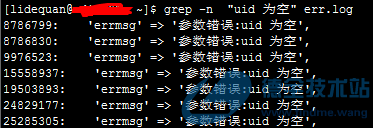-
博文分类专栏
- Jquery基础教程
-

-
- 文章:(15)篇
- 阅读:49771
- shell命令
-

-
- 文章:(42)篇
- 阅读:163731
- Git教程
-

-
- 文章:(36)篇
- 阅读:245232
- leetCode刷题
-

-
- 文章:(76)篇
- 阅读:150265
-
shell查找某字符串在某文件中出现行数2018-06-06 23:21 阅读(12076) 评论(1)
一、简介
有的时候,我们需要分析日志来排查错误,但是日志文件特别大,打开肯定是很慢的,也是没法接受的,我们需要的是快速定位错误出现的位置,并定向取出错误信息。
快速定位某个字符串在某文件中出现的行数,可以使用 linux中grep命令
默认情况,grep命令只会输出匹配的字符串所在的行,如下:

要想同时输出行号,可以指定参数-n,关于-n参数描述如下:
-n, --line-number print line number with output lines

现在,我们已经确定要查询的错误所在行数,就可以通过 tail和head或是sed命令输出特定的行
1、利用tail和head来输出特定的行
通过tail --help ,我们可以看到tail 默认显示最后10行,通过 -n参数可以指定从第n行数开始显示,或是显示最后n行,如下:
-n, --lines=K output the last K lines, instead of the last 10; or use -n +K to output lines starting with the Kth
也就是说:
tail -n 5 f.txt //显示f.txt最后5行 tail -n +5 f.txt //从第5行开始,显示f.txt
通过head --help ,我们可以看到head默认显示最前10行,通过 -n参数可以指定从倒数第n行开始,显示前面的所有,或是显示最前面的n行
-n, --lines=[-]K print the first K lines instead of the first 10; with the leading `-', print all but the last
也就是说:
head -n 5 f.txt //显示f.txt最前面5行 tail -n -5 f.txt //从倒数第5行开始,显示前面的所有内容
比如,在上面我们定位到了8786830行,那么,我们就可以利用tail和head,查其附近的内容(即错误前20行,后10行内容),如下:
tail -n +8786810 err.log |head -n 30
2、利用sed来输出特定的行
通过sed来查看指定的行,就比较简单,格式如下:
sed -n "n1,n2p" f.txt //查看f.txt n1行到n2行之间的内容
比如,在上面我们定位到了8786830行,那么,我们就可以利用sed,查其附近的内容(即错误前20行,后10行内容),如下:
sed -n "8786810,8786840p" err.log

 摘要视图
摘要视图
 目录视图
目录视图

